The Bainbridge Island Museum of Art just opened their Spring exhibitions. It happens to have presented two blockbuster, high quality shows. To be honest, I had hoped to see them both but I could not do it. In fact, having gone through the main exhibition downstairs, “Americans Incarcerated: A Family’s Story of Social Justice,” I knew I could not even take all of it in in one visit. The exhibit is a shared artistic journey told through the artwork of Jan and Chris Hopkins. The basic premise is to learn, and tell the stories of, Jan’s family who faced the “Internment” of Japanese American Citizens at the beginning of WWII. Upstairs is a major exhibition of book arts curated by Cynthia Sears and Catherine Alice Michaelis called “Boundless.” The exhibition demonstrates the breadth of the book arts field, and the importance of the Museum’s book arts exhibition program and collection. It is memorialized with a catalog. Both of these exhibitions will be up until June 22.
Until the early 1990s, Jan Hopkins was a basket artist, having been wowed by a museum exhibition in Arizona (1988) and deciding to learn the craft using traditional materials. As those materials became scarce or restricted, she explored creating in different materials. Because she was never “just” a basket maker, and had been a creative her whole life, this juncture allowed her to explore. In the process of developing new style and form, she also began exploring who she was and began putting her history into her work. This exhibition arose out of those discoveries.
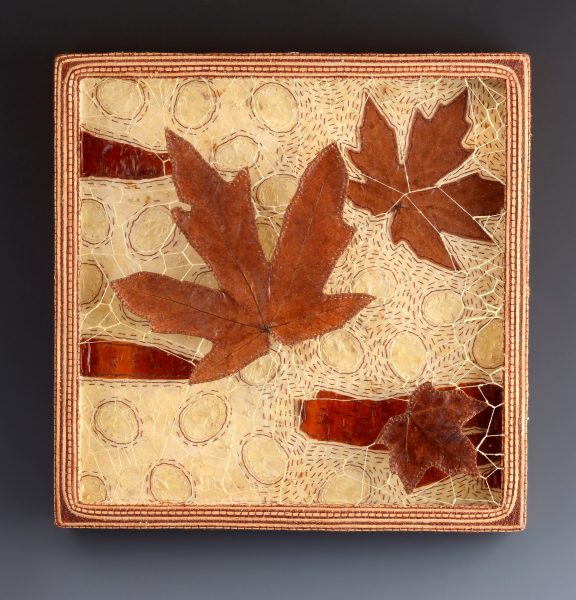
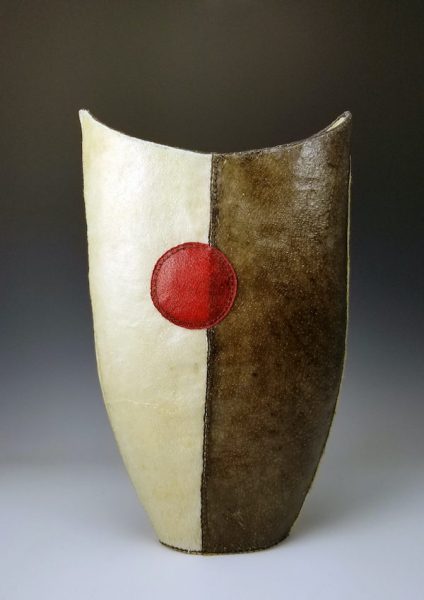
Jan Hopkins’ sculptures are 3-dimentional free standing and wall-mounted works. Their detailing is phenomenal. Most commonly pointed out are what I call the varied ingredients as Hopkins found her way to alternative materials. These new materials are often pointed out as they are very surprising. For instance, “Frozen in Time” is created with Maple leaves, birch bark, cantaloupe peal, weathered hydrangea petals, lunaria seed pod centers, cedar bark, Ostrich shell, beads and waxed linen. Other materials may include the peels of grapefruit, pomegranate and melon, watch parts, and halibut and other fish skins.
However wonderful those materials are to enjoy, these sculptures are carefully composed. There are “inner” and “outer” stories to them, interior and exterior lives. “Emerging from Darkness,” for example, tells the story of her Grandfather. The red circle, the hinomaru (represents the Sun), is the center of the darkness. The interior on the opposite side from this Sun is sewn the Japanese letter for the 1st Generation. On the reverse side of this vessel is another hinomaru (Sun) that is moving away from the darkness. Opposite that side on the interior is the sewn letter for the 3rd Generation.
Hopkins’ first torso sculpture was about the iconic, “goddess-like” person Marilyn Monroe (not part of this exhibition). The exterior was about the positive persona that Marilyn represented publicly, but the interior was all about the self-doubting side of the Norma Jean person she was, including phrases in Monroe’s own words. The torso-form sculptures in this exhibition are wonderful artworks, just make sure you take time to consider their interiors as well.
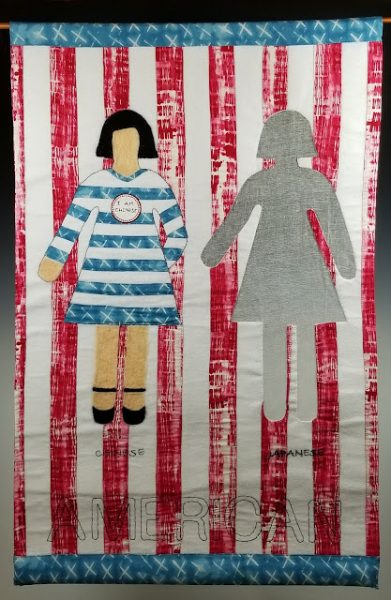
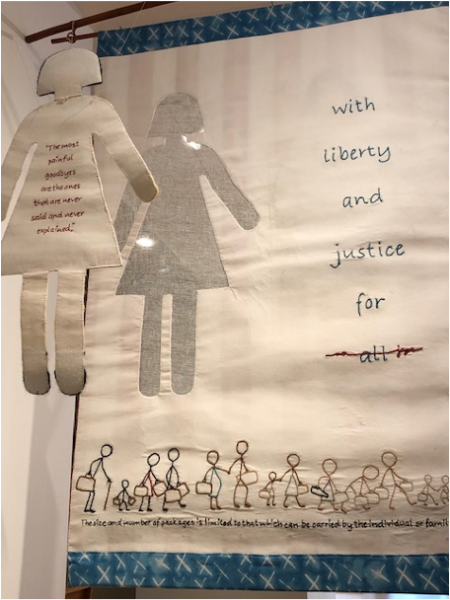
In “Cut From the Same Cloth,” the two-sided installation work, Hopkins alludes to her mother’s story of having a Chinese American best friend who began wearing a pin that would attempt to distinguish her from the Japanese American citizens who were ferociously discriminated against. The phrase on the backside, “with liberty and justice for all,” where the last word is crossed out, echos the crossed-out words of another sculpture, “Spellbound – The Power of Words.” Hand-embroidered onto the back of the torso-form sculpture are the euphemistic words used for years that described the exclusion experience, and all are crossed-out and corrected words provided. Examples: Relocation – forced removal, and Interned – incarcerated. The artist did not, in this case, come up with these on her own, but were part of the concerted effort to correct the record by the Japanese American Citizens League, updated as recently as 2020. [For a deeper understanding see: Words Can Lie or Clarify by Aiko Herzig-Yoshinaga.]
Chris Hopkins is clearly a master painter, with a realism that comes from a career in illustration at the highest level. Viewing his paintings are seductive on one level which makes them all the more chilling as you read their narrative features. Several “simple” paintings, such as ”Till Death Do Us Part,” which shows a child hugging her dog, are anything but simple. The hug is a good-bye, and the shadows you’d expect, are actually in the shape of US soldiers waiting to remove the family members to the concentration camps. Several works depict gorgeous portraits of young men and women engaged in their own American dream, yet showing the rapid disintegration of their dreams. The great many paintings and drawings in this exhibition vividly give us glimpses of the stories of the horrible repercussions of President Roosevelt’s Executive Order 9066 , just a few of the many, over 100,000, lives upended.


This exhibition is an outgrowth of an exhibition of the same name held in 2018 at the Shack Art Center in Seattle. At that time the collaboration of this artistic pair of wife and husband was powerful, and has been added to ever since as it takes time to learn, come to grips with, and in some way record the stories and events. Jan Hopkins’ sister Judy was instrumental in the historic research to understand their family’s experience, and for Jan and Chris to artistically interpret it. Such stories, even shared among family members, is difficult and hard to let out after such traumatic experiences.
Also presented was a very generous amount of additional information detailing the historic and honorable relationship between the Japanese-Americans and the Bainbridge Island Community from around 1840 through the mid 1940s. Large wall-mounted collages of images and news clippings take visitors on a tour of those relationship, especially around the time of the forced removal and subsequent incarceration of the Island’s fellow neighbors who were Japanese American. The curators, Greg Robinson and Amy Sawyer provide numerous information boards along the walls following the exhibition as well as in a loose-leaf binder full of additional historic information. The combined effort of the Hopkins’ artwork with that of the curators bring to the Museum and its visitors a deep emotional and historic immersion into the period and the experience, and that is worth our time.
CLICK HERE TO READ OTHER FIRST FRIDAY FOCUS & EBB and FLOW ARTICLES BY BILL
Ebb & Flow: “Threads of Connection” Jason Devinney and Caroline Cooley Browne
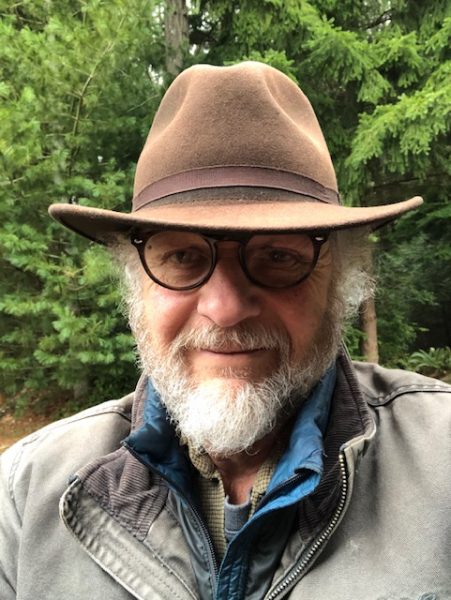
ABOUT BILL BARAN-MICKLE: 2020 Island Treasure Awardee. Recently, Bill has enjoyed exhibiting in several international art biennial exhibitions. Of the three in which he has participated, he won Third Place for Sculpture from the European Confederation of Art Critics in the Chianciamo Biennale, at the Chianciano Art Museum in Italy in 2011, and First Place in Applied Arts in the London Biennale of 2013. In 2013 alone, he will have participated in eight exhibitions: from London to a two-person exhibition near home. In addition, Bill was asked to be a representative for CCAC’s exhibition celebrating 100 years of the Metals Department, and a mix of group shows in New York City, Miami, Seattle and Las Vegas. Bill is the designer of the 10 foot Equitorial Bowstring Sundial located at the Richie Observatory in Battle Point Park on Bainbridge Island, WA and completed in 2015.